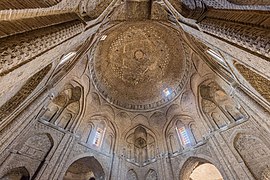Art History Marilyn Stokstad Third Edition Notes From The Universe
Captures these miracles in a Mannerist composition that recalls Pontormo (see FIG. 21-30), packing the pictorial field with figures and eliminating specific reference to the spatial setting. An angel lifts Orgaz's ghostly soul along the central axis of the painting toward the enthroned Christ at the apex of the canvas.
The otherworldly luminescence emanating from Christ in this heavenly vision is quite unlike the natural light below, where El Greco surrounded the burial scene with portraits of the local aristocracy and religious notables. He placed his own 8-year-old. Son at the lower left next to St. Stephen and signed the painting on the boy's white kerchief. El Greco may also have put his own features on the man just above the saint's head, the only other figure who, like the child, looks straight out at the viewer. Flemish artist Jean Clouet (c. 1540) found great favor at the royal court, especially as a portrait painter.

Had so far of the universe of inventors; any finding concerning inventors, identified in either uniform or diverse fashion. Art history reveals that art scholars consider Pollock and Warhol the two greatest painters born in the twentieth century. Marilyn Stokstad, Art History, revised second ed. (Upper Saddle River, NJ:.

About the same time that he became principal court painter in 1527, he produced an official portrait of the king (FIG. Clouet created a flattering image of Francis by modulating the king's distinctive features with soft shading and highlighting the nervous activity of his fingers.
At the same time he conceived an image of pure power. Elaborate, puffy sleeves broaden the king's shoulders to fill the entire width of the panel, much as Renaissance parade armor turned scrawny men into giants. The detailed rendering of the delicately worked costume of silk, satin, velvet, jewels, and gold embroidery could be painted separately from the portrait itself. Royal clothing was often loaned to the artist or modeled by a servant to spare the 'sitter' the boredom of posing. In creating such official portraits, the artist sketched the subject, then painted a prototype that, upon approval, became the model for numerous replicas made for diplomatic and family purposes. People consider him the father of surrealism (Bosh) His stuff is so dreamlike, but it is very Northern highly detailed and symbolic. Xforce Keygen Autocad 2013 64 Bit Windows 8 Free Download there. So different for this time period.
Depicted the sort of imaginative fantasies more often associated with medieval than Renaissance art. A superb colorist and virtuoso technician, Bosch spent his career in the town whose name he adopted, 's-Hertogenbosch. Bosch's religious devotion is certain, and his range of subjects shows that he was well educated. Bosch's religious devotion is certain, and his range of subjects shows that he was well educated. Challenging and unsettling paintings such as his GARDEN OF EARTHLY DELIGHTS (FIG. 22-20) have led modern scholars to label Bosch both a mystic and a social critic.
The subject of the triptych seems to be founded on Christian belief in the natural state of human sinfulness, but it was not painted for a church. In the left wing, God introduces doll-like figures of Adam and Eve, under the watchful eye of the owl of perverted wisdom. The owl symbolizes both wisdom and folly. Folly had become an important concept to the northern European humanists, who believed in the power of education. They believed that people would choose to follow the right way once they knew it. Here the owl peers out from an opening in the spherical base of a fantastic.
Pink fountain in a lake from which vicious creatures creep out into the world. Download Aplikasi Kamera Tembus Pandang Java Gratis on this page. In the central panel, the Earth teems with such monsters, but also with vivacious human revelers and luscious huge fruits, symbolic of fertility and sexual abandon.
In hell, at the right, sensual pleasures—eating, drinking, music, and dancing—become instruments of torture in a dark world of fire and ice. Adams Ovation Driver Reviews. The emphasis in the right wing on the torments of hell, with no hint of the rewards of heaven, seems to caution that damnation is the natural outcome of a life lived in ignorance and folly, that humans ensure their damnation through their self-centered pursuit of pleasures of the flesh—the sins of gluttony, lust, greed, and sloth—outlined with such fantastic and graphic abandon in the central panel. Luscious fruits of obvious sexual symbolism—strawberries, cherries, grapes, and pomegranates—appear everywhere in the garden, serving as food, as shelter, and even as a boat. Is human life as fleeting and insubstantial as the taste of a strawberry?